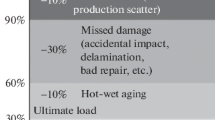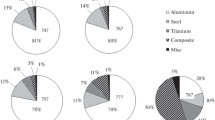An obligatory condition for creating a competitive aircraft (AC) is to ensure low operating costs by reducing downtime and rational organization of maintenance and repair through continuous monitoring, diagnosis, and prediction of the AC condition. For monitoring, diagnosing, and predicting aircraft condition in recent decades the list of parameters recorded on board is continuously expanding. Great prospects in this direction are associated with the creation and implementation of so-called smart materials that can monitor their condition and even actively resist damage. This article presents results of research showing the fundamental possibility of constructing a strain curve for structural metal based on hardness measurement by ultrasonic contact impedance. During performance of experiments on aluminium alloy AMg6 samples a correlation relationship is established for strength properties obtained on the basis of a stress-strain curve with hardness values during tests that make it possible to evaluate material condition with a complex stress-strained state. Implementation of this approach demonstrates the expediency of predicting the current mechanical condition and residual life of metal structures based on analysis of dynamics of the change in structural material hardness parameters.










Similar content being viewed by others
References
N. A. Yurlova, “Clever materials and structures: fantasy or reality,” Vestnik. Perm. Fed. Issled. Tsenter, No. 2, 33–48 (2013).
A. A. Basheer, “Advances in the smart materials applications in the aerospace industries,” Aircraft Engineering and Aerospace Technology, 92, No. 7, 1027–1035 (2020).
Keshav Sharma and G. Srinivas, “Flying smart: Smart materials used in aviation industry,” Materials Today: Proceedings, 27, Part 1, 244–250 (2020); ISSN 2214-7853.
“Aircraft systems,” Ékspress-informatsiya, No. 8, GosNIIAS, Moscow (2018).
L. Potlatidi, “On the way to a third resource control strategy” [Electronic resource]; Access regime: URL www.pmz.ru/pr/other/aviadv/IB-16/IB-16_26/ (Access date: 12.04.2021).
H. Mayer, W. Haydn, R. Schuller, et al., “Very high cycle fatigue properties of bainitic high carbon-chromium steel,” Int. J. of Fatigue, 31, 242–249 (2009).
J. Man, K. Obrtlik, M. Petrenec, et al., “Stability of austenitic 316L steel against martensite formation during cyclic straining,” Procedia Engineering, 10, 1279–1284 (2011).
D. Thibault, P. Bocher, M. Thomas, et al., “Reformed austenitic transformation during fatigue crack propagation of 13%Cr–4%Ni stainless steel,” Mater. Sci. and Eng. A, 528, 6519–6526 (2011).
Y. Estrin and A. Vinogradov, “Extreme grain refinement by severe plastic deformation: A wealth of challenging science,” Acta Materialia, 61, 782–817 (2013).
I. G. Roberov, D. K. Figurovskii, M. A. Kiselev, V. S. Grama, and D. B. Matveev, “Evaluation of the technical conditions of deformed metallic materials by non-destructive monitoring,” Proc. VII Internat. Conf. “Functional nanomaterials and high purity substances,” Suzdal’ (2018).
A. Keropyan and S. Gorbatyuk, “Impact of roughness of interacting surfaces of the wheel-rail pair on the coefficient of friction in their contact area,” Procedia Engineering, 150, 406–410 (2016).
I. E. Volokitina, A. V. Volokitin, A. B. Naizabekov, and S. N. Lezhnev, “Change in structure and mechanical properties of grade А0 aluminum during implementation of a combined method of ECAE–drawing deformation,” Metallurgist, 63, (9–10) 978–983 (2020).
A. G. Korchunov, M. A. Polyakova, D. V. Konstantinov, and M. Dabalá, “Mechanical properties of prestressing strands and how they tend to change under thermo-mechanical treatment,” CIS Iron and Steel Review, 18, 14–19 (2019); https://doi.org/10.17580/cisisr.2019.02.03.
S. M. Gorbatyuk and A. V. Kochanov, “Method and equipment of mechanically strengthening the surface of rolling mill rolls,” Metallurgist, 56 (3–4), 279–283 (2012).
E. A. Chernyshov, A. D. Romanov, B. S. Kaverin, V. A. Varyukhin, A. M. Ob’edkov, and N. M. Semenov, “Development of technology for preparing composite material based on aluminum strengthened with hollow ceramic microspheres,” Metallurgist, 62 (11–12), 1255–1260 (2019); https://doi.org/10.1007/s11015-019-00783-1.
R. L. Shatalov and E. A. Maksimov, “Development and application of the theory of rigid end in thin-sheet rolling,” Metallurgist, 64 (9–10), 1035–1042 (2021); https://doi.org/10.1007/s11015-021-01084-2.
S. P. Eron’ko, V. L. Danilov, A. V. Kuklev, M. Y. Tkachev, V. V. Tinyakov, and S. V. Mechik, “Experience of design and industrial application of systems for the driven feed of slag-forming mixtures into the crystallizers of slab CCM,” Metallurgist, 64 (3–4), 214–222 (2020); https://doi.org/10.1007/s11015-020-00986-x.
S. P. Eron’ko, V. L. Danilov, M. Y. Tkachev, V. V. Tinyakov, and E. A. Ponomareva, “Model studies and modernization of a manipulator for tapping pout replacement in continuous steel casting,” Metallurgist, 64, (3–4), 301–308 (2020); https://doi.org/10.1007/s11015-020-00996-9.
E. A. Maksimov, R. L. Shatalov, and V. G. Shalamov, “Calculation of residual stresses and parameters of sheet springing on roller leveller,” Izvestiya Ferrous Metallurgy, 64, No. 1, 14–20 (2021); https://doi.org/10.17073/0368-0797-2021-1-14-20.
A. Y. Albagachiev, A. M. Keropyan, A. A. Gerasimova, and O. A. Kobelev, “Determination of rational friction temperature in lengthwise rolling,” CIS Iron and Steel Review, 19, 33–36 (2020); https://doi.org/10.17580/cisisr.2020.01.07.
G. D. Del’, Stress Determination in Plastic Region from Hardness Distribution [in Russian], Mashinostroenie, Moscow (1971).
“Determination of stress-strained state by hardness testing” [Electronic source], Access regime: URLhttp://metal-archive.ru/teoriyaobrabotki/207opredelenie-napryazhenno-deformirovannogo-sostoyaniyaispytaniem-tverdosti.html (Access date: 04.12.2021).
Author information
Authors and Affiliations
Corresponding author
Additional information
Translated from Metallurg, Vol. 65, No. 9, pp. 81–88, September, 2021. Russian DOI: 00260827_2021_09_81.
Rights and permissions
About this article
Cite this article
Roberov, I.G., Grama, V.S., Kiselev, M.A. et al. Study of the Creation of Aircraft Structural Smart-Materials Based on Evaluation of Strength Properties. Metallurgist 65, 1025–1035 (2022). https://doi.org/10.1007/s11015-022-01243-z
Received:
Published:
Issue Date:
DOI: https://doi.org/10.1007/s11015-022-01243-z




